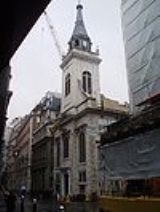
St Edmund the King and Martyr
Encyclopedia
- For the 9th-century King of East Anglia, Martyr and Saint, see Edmund the MartyrEdmund the MartyrSt Edmund the Martyr was a king of East Anglia, an Anglo-Saxon kingdom which today includes the English counties of Norfolk, Suffolk and Cambridgeshire.D'Evelyn, Charlotte, and Mill, Anna J., , 1956. Reprinted 1967...
.
St Edmund, King and Martyr is an Anglican church in Lombard Street
Lombard Street, London
Lombard Street is a street in the City of London.It runs from the corner of the Bank of England at its north-west end, where it meets a major junction including Poultry, King William Street, and Threadneedle Street, south-east to Gracechurch Street....
, in the City of London
City of London
The City of London is a small area within Greater London, England. It is the historic core of London around which the modern conurbation grew and has held city status since time immemorial. The City’s boundaries have remained almost unchanged since the Middle Ages, and it is now only a tiny part of...
dedicated to St Edmund the Martyr
Edmund the Martyr
St Edmund the Martyr was a king of East Anglia, an Anglo-Saxon kingdom which today includes the English counties of Norfolk, Suffolk and Cambridgeshire.D'Evelyn, Charlotte, and Mill, Anna J., , 1956. Reprinted 1967...
.
History
In 1292, the church is first recorded as 'Saint Edmund towards Garcherche', and it reappears in 1348 as 'Saint Edmund in Lombardestrete'. John Stow, in his Survey of London 1598, revised during 1603, refers to it also as St Edmund Grass Church.This medieval church was destroyed in the Great Fire
Great Fire of London
The Great Fire of London was a major conflagration that swept through the central parts of the English city of London, from Sunday, 2 September to Wednesday, 5 September 1666. The fire gutted the medieval City of London inside the old Roman City Wall...
of 1666, and Sir Christopher Wren built the present building 1670-1679, with a tower designed like a lighthouse ornamented at the angles by flaming urns in allusion to the Great Fire. The position of the church is unusual as it is orientated with the altar at the north, instead of east.
The essayist Joseph Addison
Joseph Addison
Joseph Addison was an English essayist, poet, playwright and politician. He was a man of letters, eldest son of Lancelot Addison...
was married here in 1716. The church was restored in 1864 and 1880. It was damaged by bombing in 1917.
It has housed the London Centre for Spirituality and its associated bookshop since 2001, but is still a consecrated Church.
The church was designated a Grade I listed building on 4 January 1950.

